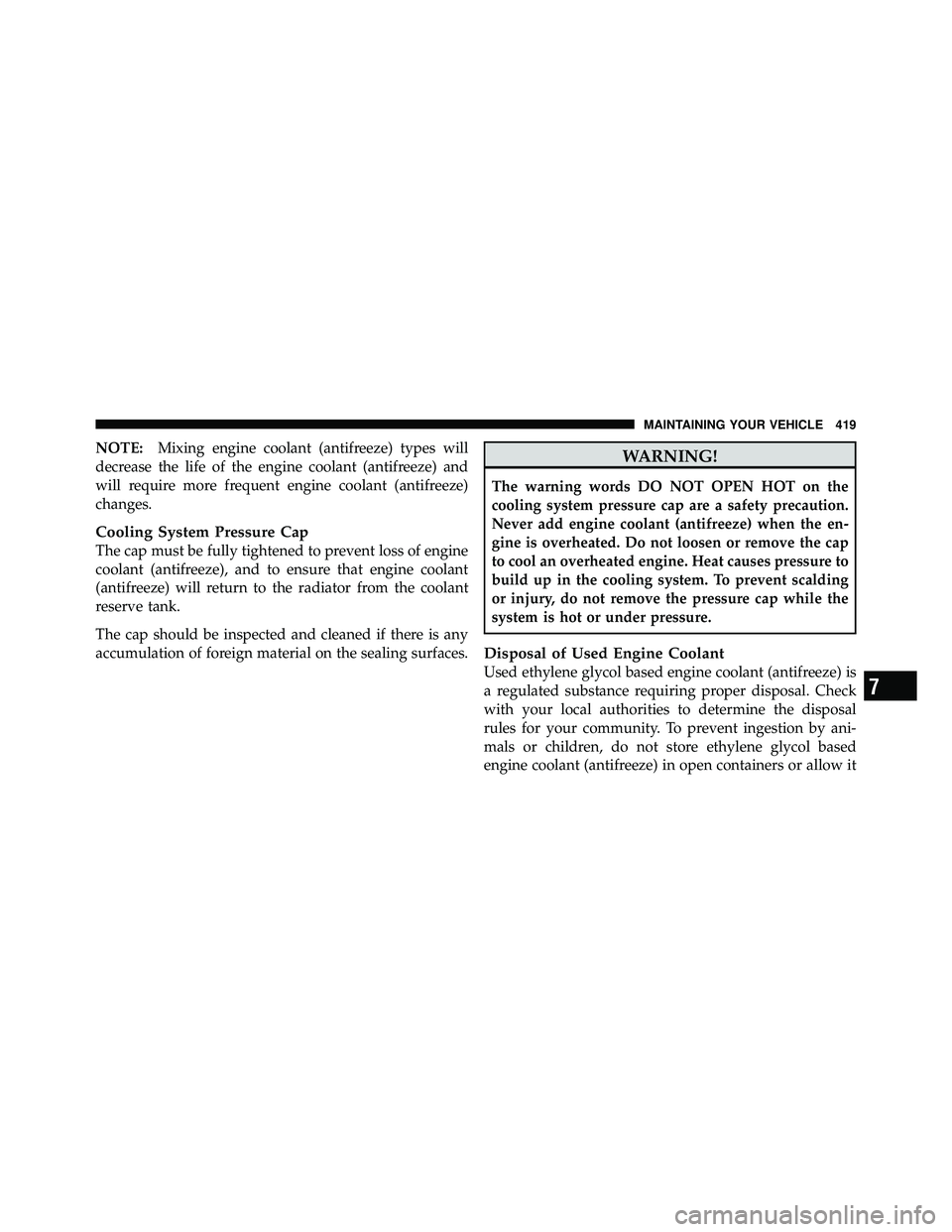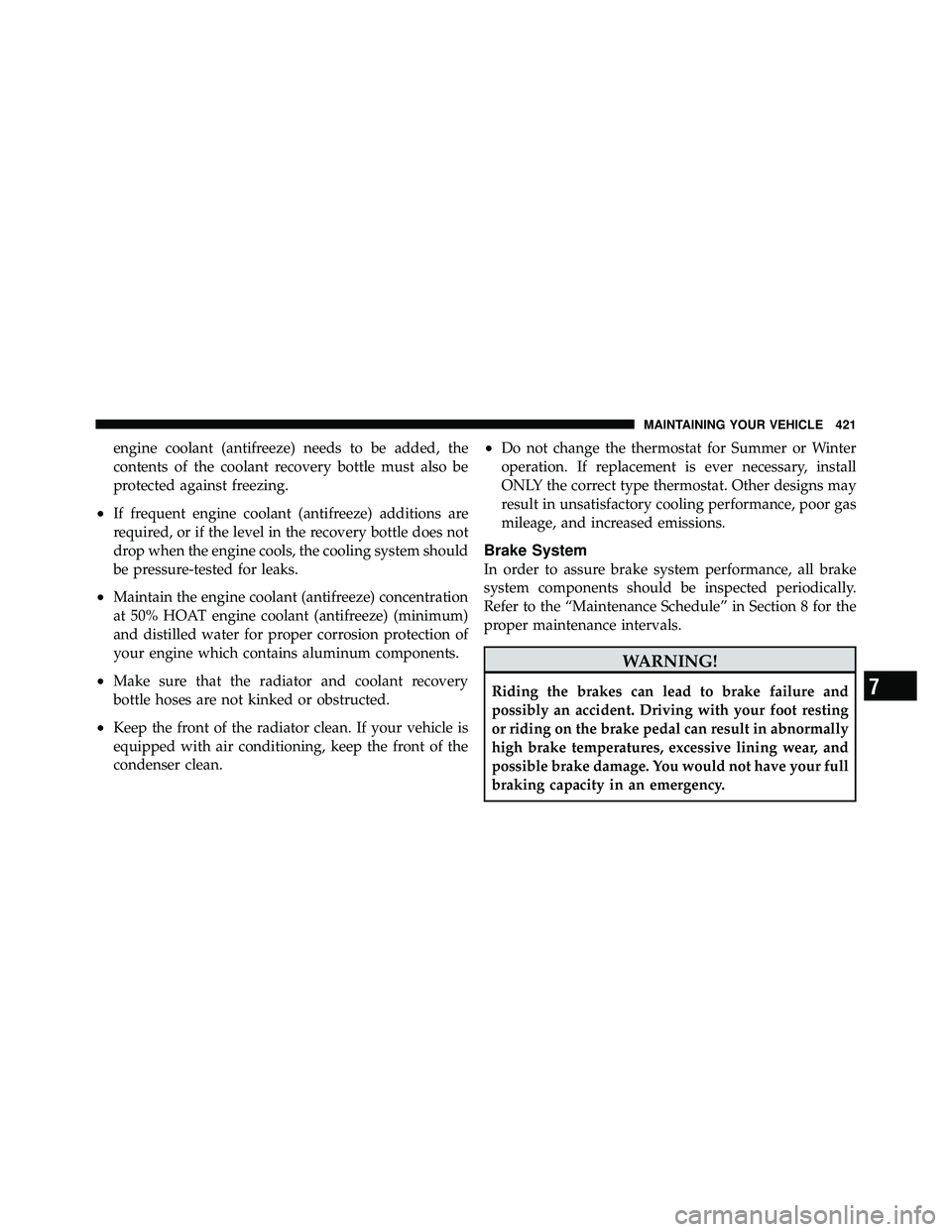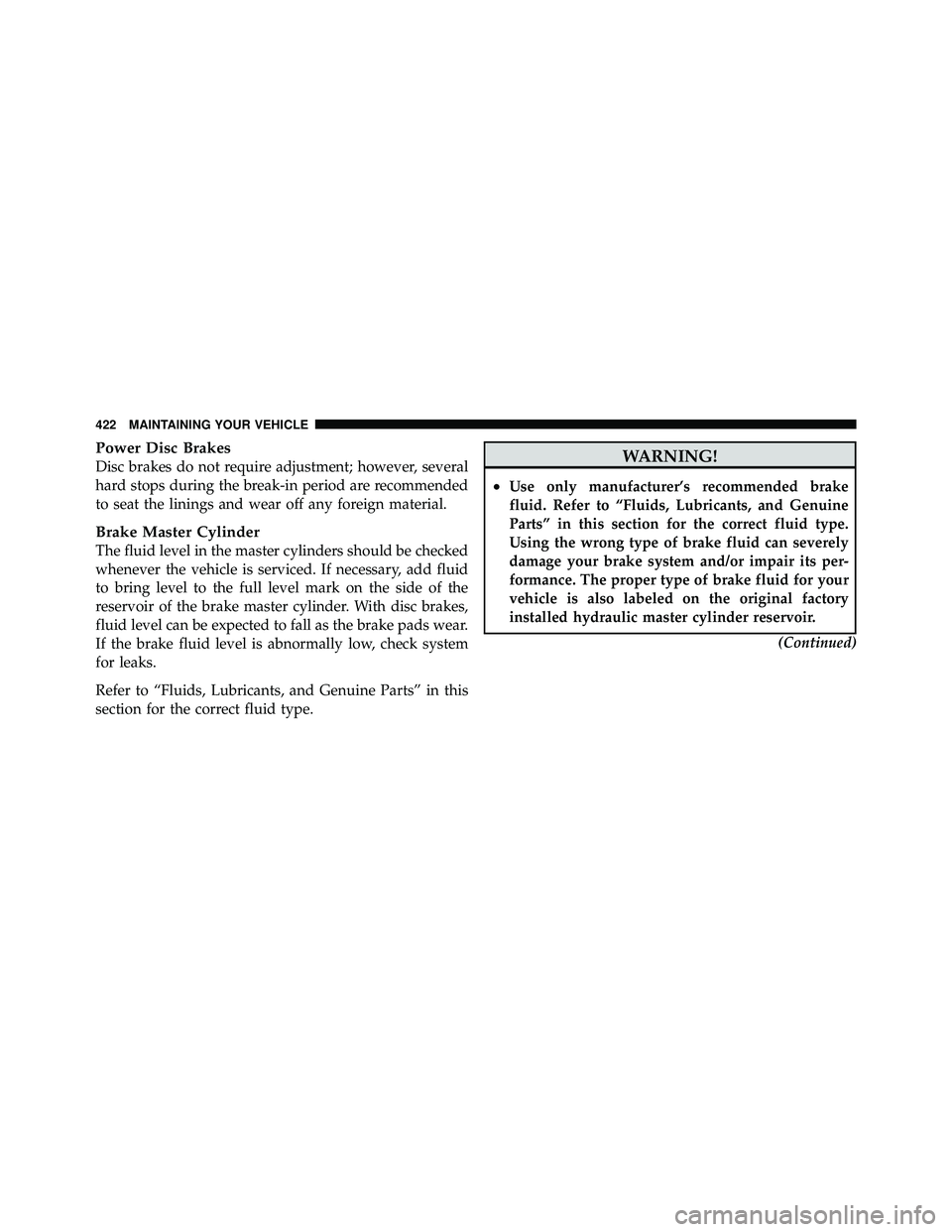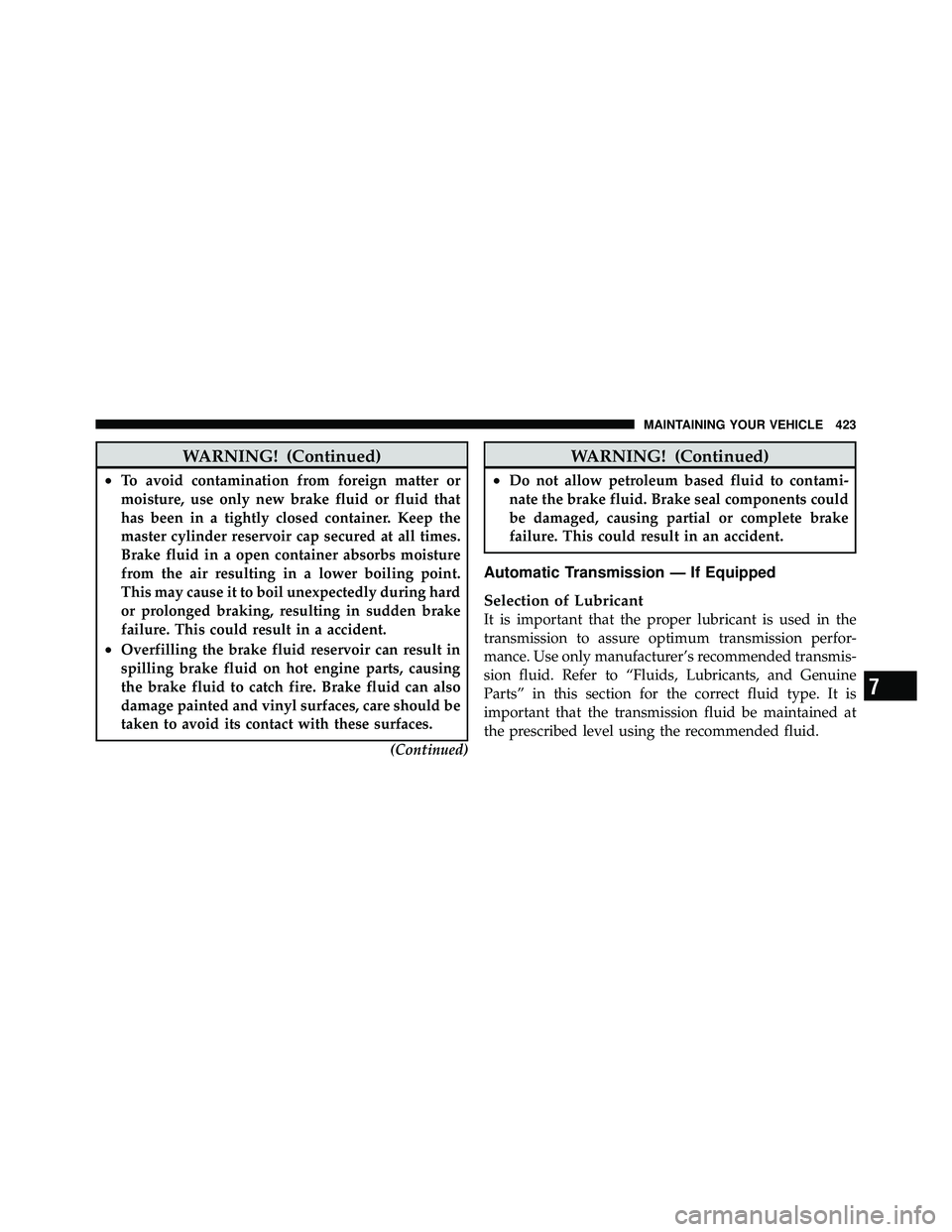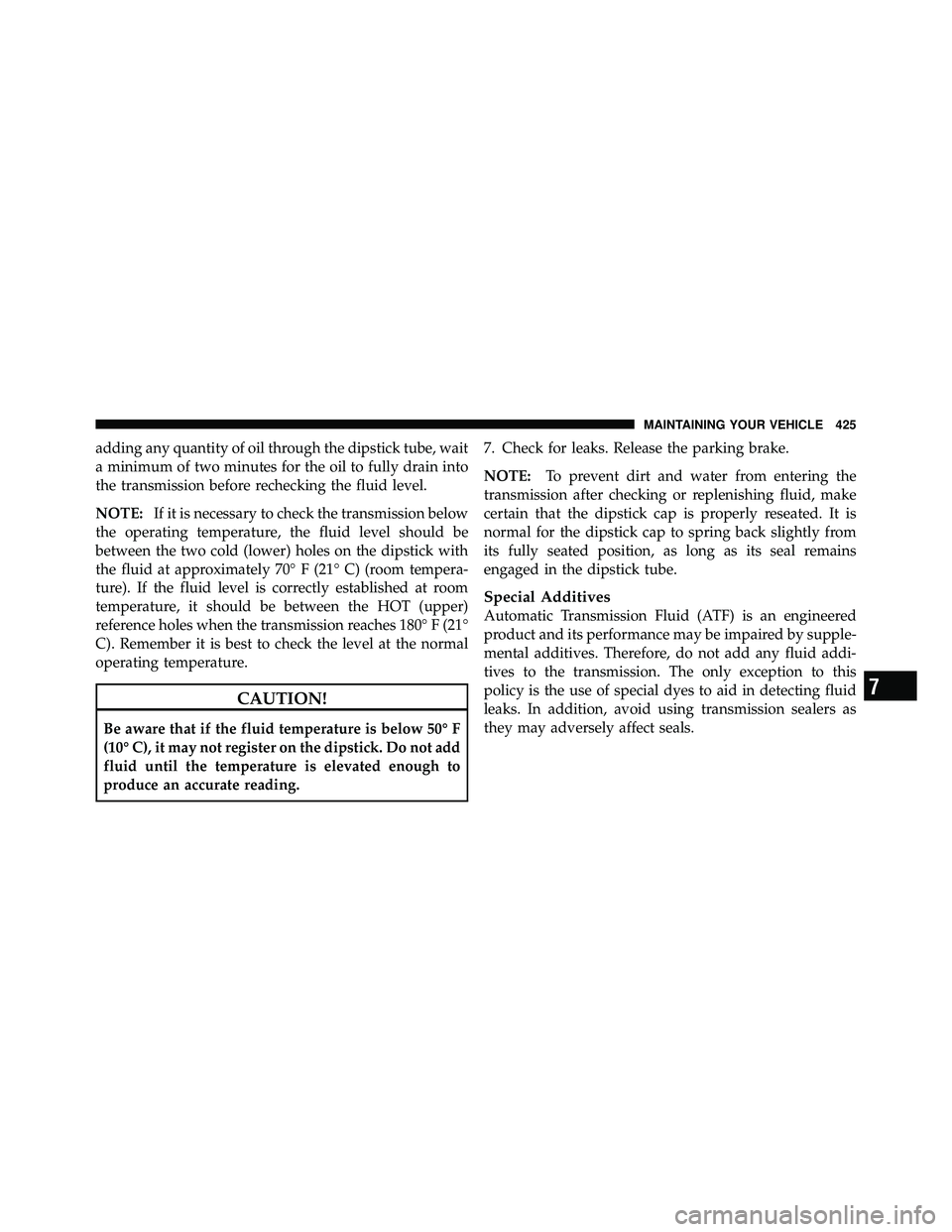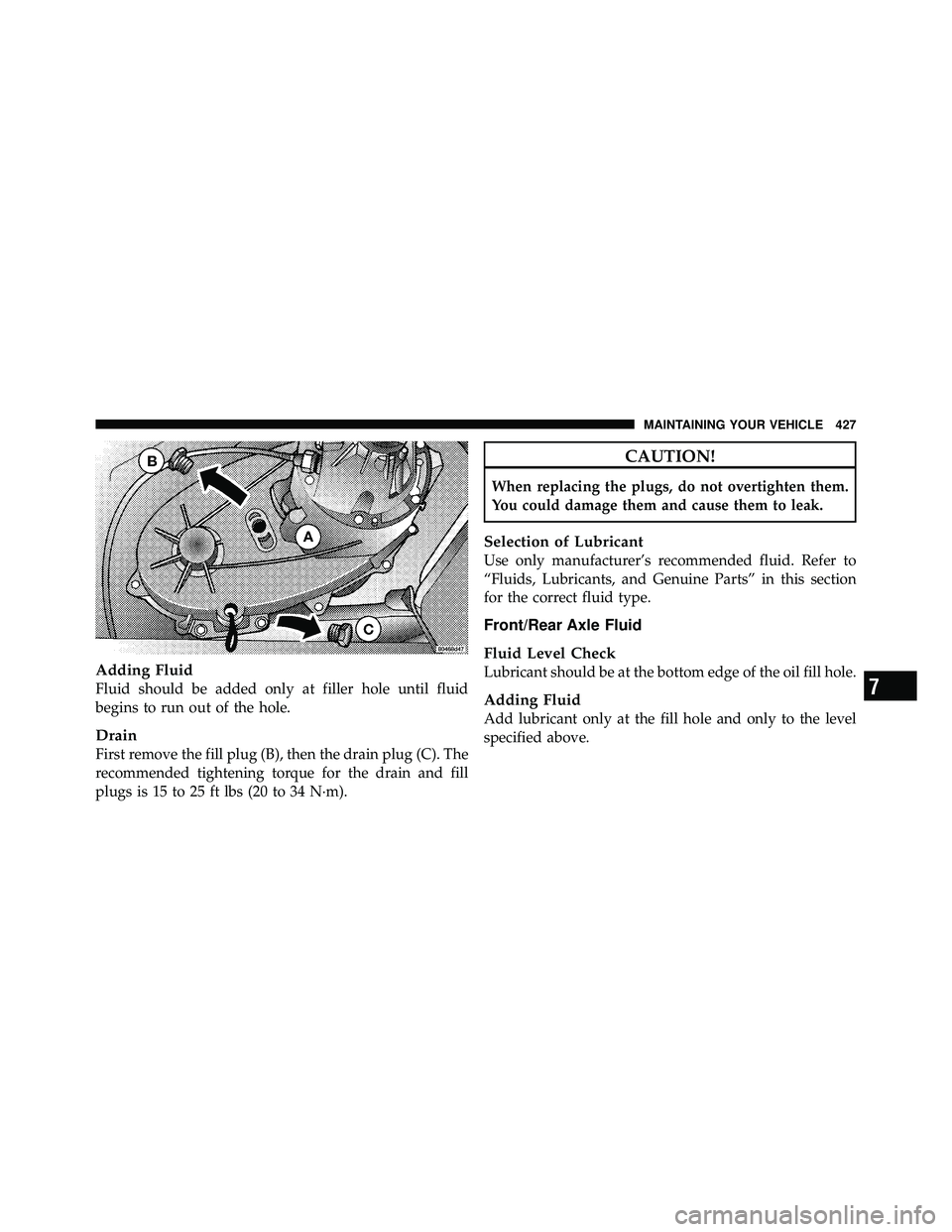JEEP WRANGLER 2009 Owners Manual
WRANGLER 2009
JEEP
JEEP
https://www.carmanualsonline.info/img/16/56060/w960_56060-0.png
JEEP WRANGLER 2009 Owners Manual
Trending: remove seats, clock setting, oil pressure, child seat, adding oil, transmission, gas type
Page 421 of 502
Page 422 of 502
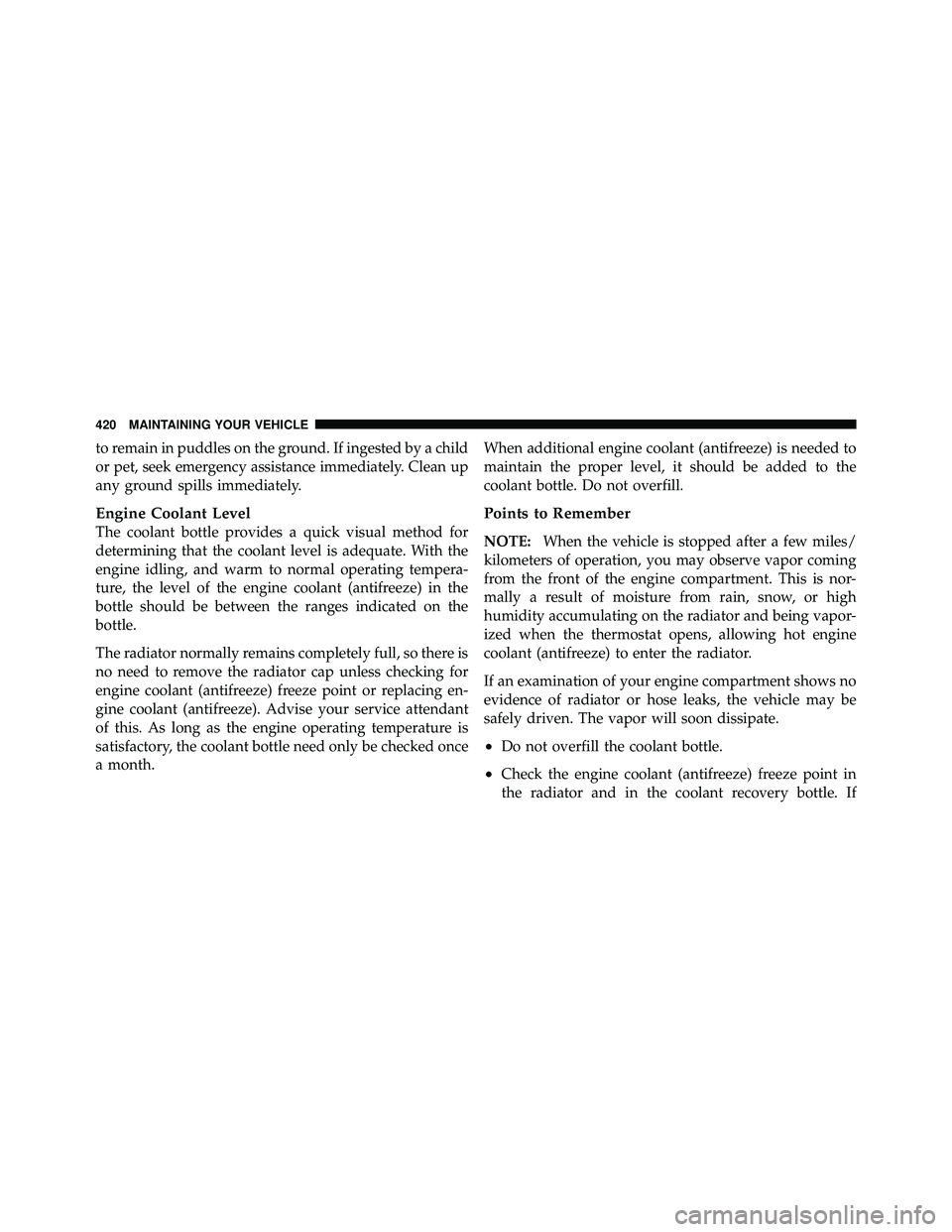
to remain in puddles on the ground. If ingested by a child
or pet, seek emergency assistance immediately. Clean up
any ground spills immediately.
Engine Coolant Level
The coolant bottle provides a quick visual method for
determining that the coolant level is adequate. With the
engine idling, and warm to normal operating tempera-
ture, the level of the engine coolant (antifreeze) in the
bottle should be between the ranges indicated on the
bottle.
The radiator normally remains completely full, so there is
no need to remove the radiator cap unless checking for
engine coolant (antifreeze) freeze point or replacing en-
gine coolant (antifreeze). Advise your service attendant
of this. As long as the engine operating temperature is
satisfactory, the coolant bottle need only be checked once
a month.When additional engine coolant (antifreeze) is needed to
maintain the proper level, it should be added to the
coolant bottle. Do not overfill.
Points to Remember
NOTE:
When the vehicle is stopped after a few miles/
kilometers of operation, you may observe vapor coming
from the front of the engine compartment. This is nor-
mally a result of moisture from rain, snow, or high
humidity accumulating on the radiator and being vapor-
ized when the thermostat opens, allowing hot engine
coolant (antifreeze) to enter the radiator.
If an examination of your engine compartment shows no
evidence of radiator or hose leaks, the vehicle may be
safely driven. The vapor will soon dissipate.
•Do not overfill the coolant bottle.
•Check the engine coolant (antifreeze) freeze point in
the radiator and in the coolant recovery bottle. If
420 MAINTAINING YOUR VEHICLE
Page 423 of 502
Page 424 of 502
Power Disc Brakes
Disc brakes do not require adjustment; however, several
hard stops during the break-in period are recommended
to seat the linings and wear off any foreign material.
Brake Master Cylinder
The fluid level in the master cylinders should be checked
whenever the vehicle is serviced. If necessary, add fluid
to bring level to the full level mark on the side of the
reservoir of the brake master cylinder. With disc brakes,
fluid level can be expected to fall as the brake pads wear.
If the brake fluid level is abnormally low, check system
for leaks.
Refer to “Fluids, Lubricants, and Genuine Parts” in this
section for the correct fluid type.
Page 425 of 502
Page 426 of 502
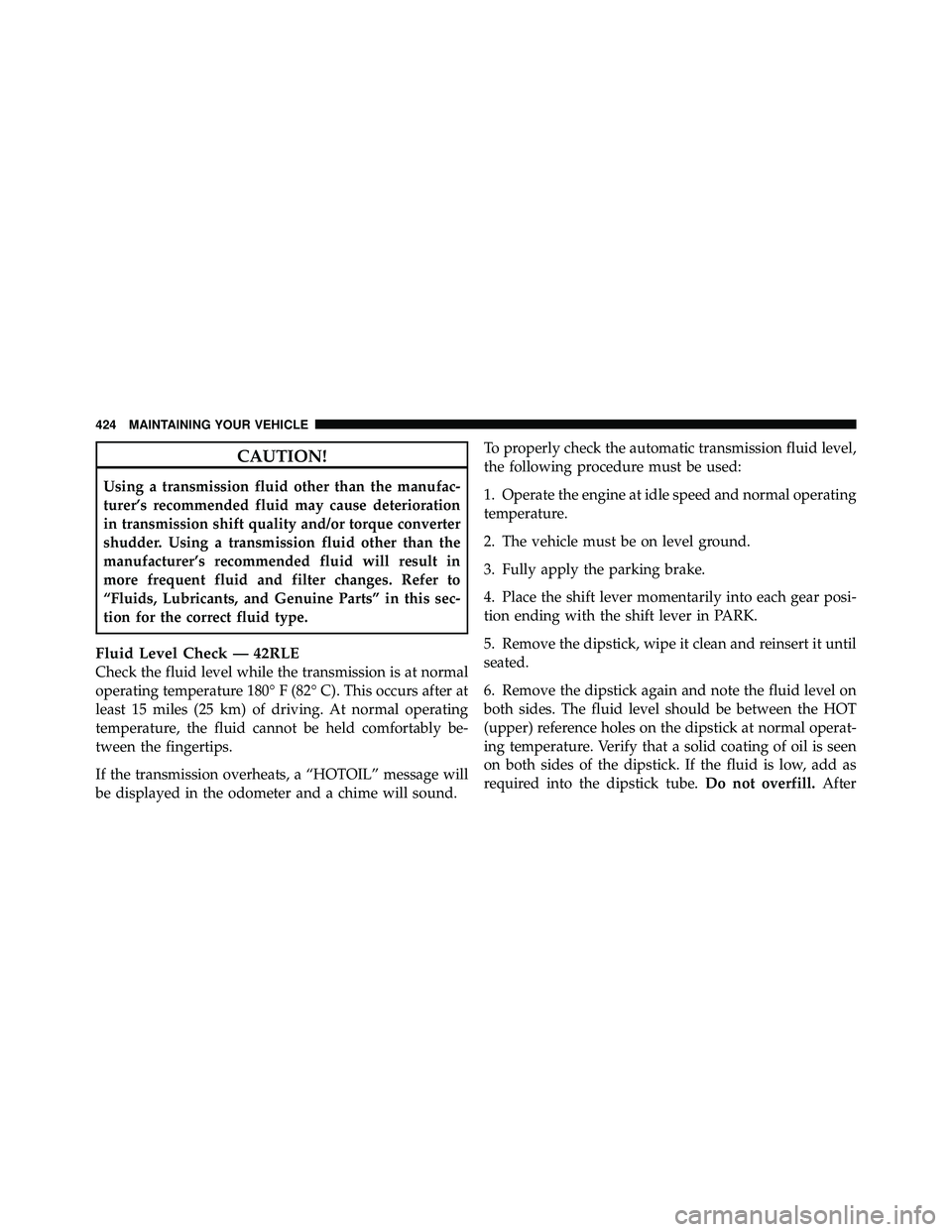
CAUTION!
Using a transmission fluid other than the manufac-
turer’s recommended fluid may cause deterioration
in transmission shift quality and/or torque converter
shudder. Using a transmission fluid other than the
manufacturer’s recommended fluid will result in
more frequent fluid and filter changes. Refer to
“Fluids, Lubricants, and Genuine Parts” in this sec-
tion for the correct fluid type.
Fluid Level Check — 42RLE
Check the fluid level while the transmission is at normal
operating temperature 180° F (82° C). This occurs after at
least 15 miles (25 km) of driving. At normal operating
temperature, the fluid cannot be held comfortably be-
tween the fingertips.
If the transmission overheats, a “HOTOIL” message will
be displayed in the odometer and a chime will sound.To properly check the automatic transmission fluid level,
the following procedure must be used:
1. Operate the engine at idle speed and normal operating
temperature.
2. The vehicle must be on level ground.
3. Fully apply the parking brake.
4. Place the shift lever momentarily into each gear posi-
tion ending with the shift lever in PARK.
5. Remove the dipstick, wipe it clean and reinsert it until
seated.
6. Remove the dipstick again and note the fluid level on
both sides. The fluid level should be between the HOT
(upper) reference holes on the dipstick at normal operat-
ing temperature. Verify that a solid coating of oil is seen
on both sides of the dipstick. If the fluid is low, add as
required into the dipstick tube.
Do not overfill.After
424 MAINTAINING YOUR VEHICLE
Page 427 of 502
Page 428 of 502
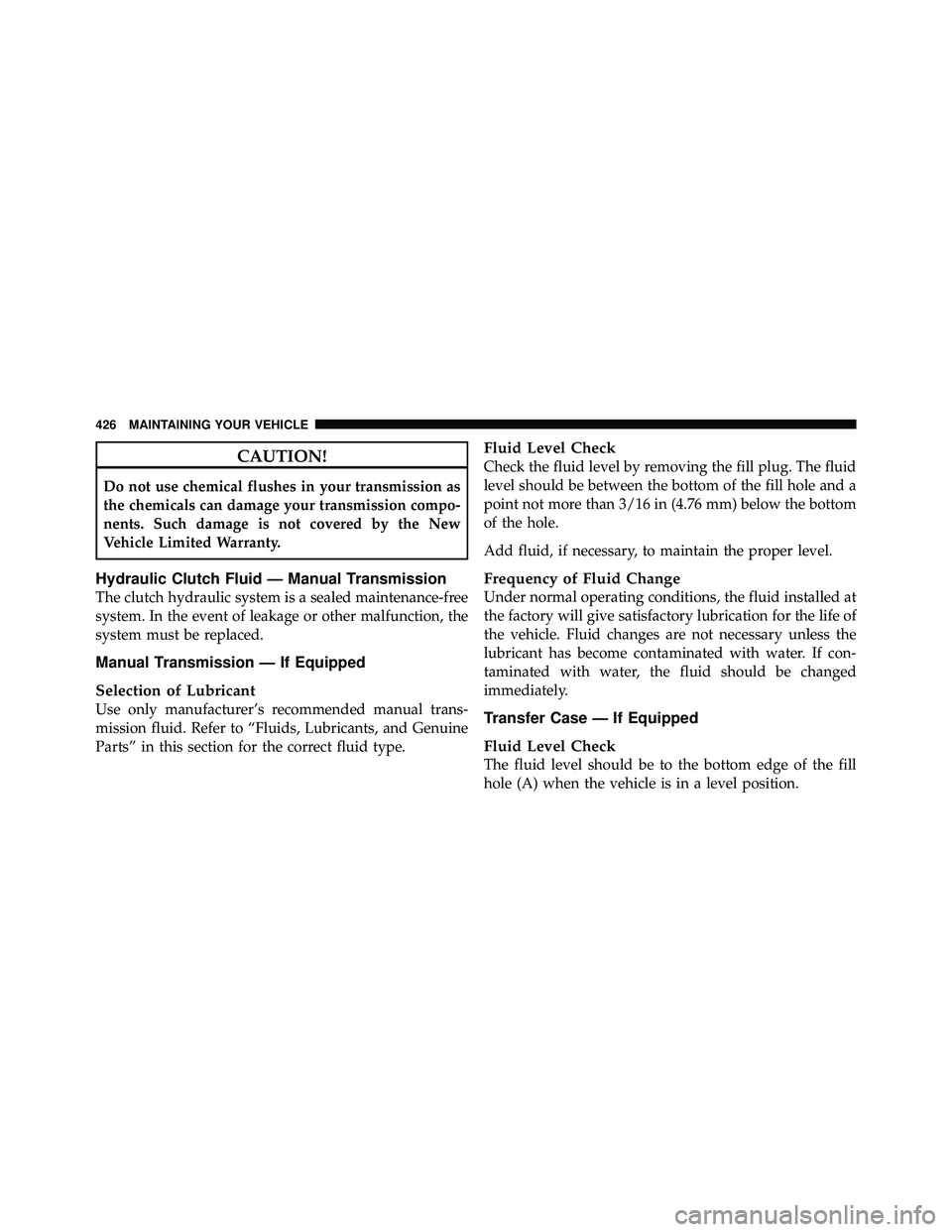
CAUTION!
Do not use chemical flushes in your transmission as
the chemicals can damage your transmission compo-
nents. Such damage is not covered by the New
Vehicle Limited Warranty.
Hydraulic Clutch Fluid — Manual Transmission
The clutch hydraulic system is a sealed maintenance-free
system. In the event of leakage or other malfunction, the
system must be replaced.
Manual Transmission — If Equipped
Selection of Lubricant
Use only manufacturer’s recommended manual trans-
mission fluid. Refer to “Fluids, Lubricants, and Genuine
Parts” in this section for the correct fluid type.
Fluid Level Check
Check the fluid level by removing the fill plug. The fluid
level should be between the bottom of the fill hole and a
point not more than 3/16 in (4.76 mm) below the bottom
of the hole.
Add fluid, if necessary, to maintain the proper level.
Frequency of Fluid Change
Under normal operating conditions, the fluid installed at
the factory will give satisfactory lubrication for the life of
the vehicle. Fluid changes are not necessary unless the
lubricant has become contaminated with water. If con-
taminated with water, the fluid should be changed
immediately.
Transfer Case — If Equipped
Fluid Level Check
The fluid level should be to the bottom edge of the fill
hole (A) when the vehicle is in a level position.
426 MAINTAINING YOUR VEHICLE
Page 429 of 502
7
MAINTAINING YOUR VEHICLE 427
Page 430 of 502
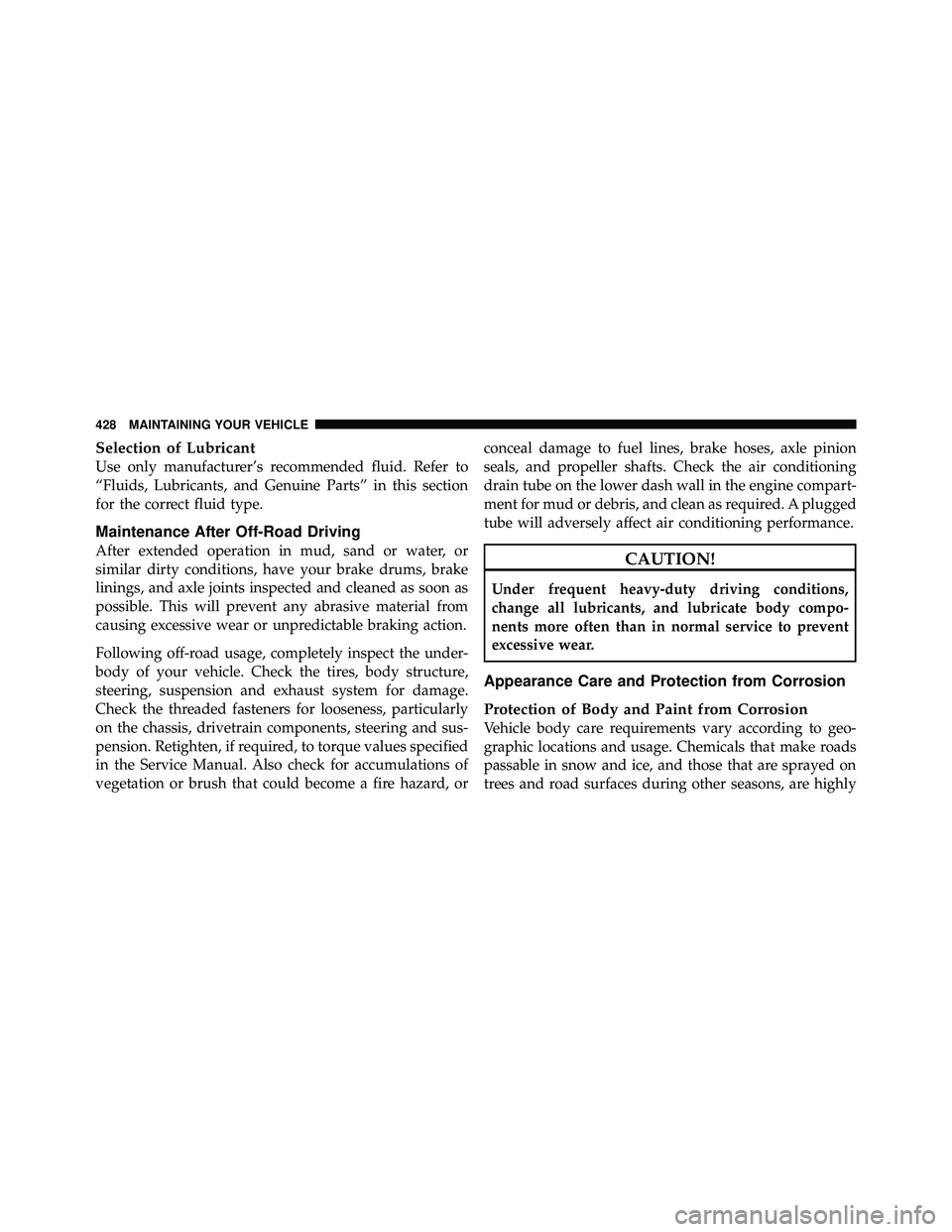
Selection of Lubricant
Use only manufacturer’s recommended fluid. Refer to
“Fluids, Lubricants, and Genuine Parts” in this section
for the correct fluid type.
Maintenance After Off-Road Driving
After extended operation in mud, sand or water, or
similar dirty conditions, have your brake drums, brake
linings, and axle joints inspected and cleaned as soon as
possible. This will prevent any abrasive material from
causing excessive wear or unpredictable braking action.
Following off-road usage, completely inspect the under-
body of your vehicle. Check the tires, body structure,
steering, suspension and exhaust system for damage.
Check the threaded fasteners for looseness, particularly
on the chassis, drivetrain components, steering and sus-
pension. Retighten, if required, to torque values specified
in the Service Manual. Also check for accumulations of
vegetation or brush that could become a fire hazard, orconceal damage to fuel lines, brake hoses, axle pinion
seals, and propeller shafts. Check the air conditioning
drain tube on the lower dash wall in the engine compart-
ment for mud or debris, and clean as required. A plugged
tube will adversely affect air conditioning performance.
Trending: window, parking brake, USB port, center console, steering, hood release, tire type
